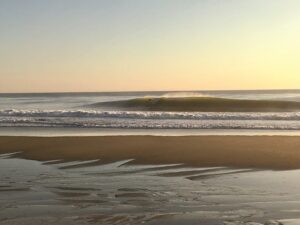When we think of surfers, we picture those people who ride waves. The ones who spend their time gliding across the faces of breaking walls of water. In truth, though, only a tiny fraction of a surfer’s time is spent standing on a board on a wave — perhaps two minutes of any given two-hour surf session. Most of what surfers do is sit still.
From their boards, surfers stare at the line between sea and sky, reading and absorbing patterns. For hundreds of minutes each day, they sit, legs on either side of their boards like stabilizing birdies on a fishing vessel. They wait, watching with practiced eyes for a shift in the shade of the horizon or in the movement in the narrow band between where they are and the line that is the beginning of the sky. The shift is what tells them a wave, or a set of waves, is coming.

Surfers’ sensitivity to that shift is so acute that recognizing it is more akin to having an intuition than it is to seeing something. Watch a collection of surfers in the water and you will see how, from time to time, they move like a herd or a flock, turning all at once and paddling for the horizon. Minutes later, a set of large waves will appear. Surfers, more than being people who surf, are pattern readers. What they develop during their years on the water is a deep kind of pattern literacy.
I first heard the words “pattern literacy” on the Waterpeople podcast — where pro free-surfers Dave Rastovich and Lauren Hill talk with people who live in direct and close connection with the ocean. The words were spoken by a West Coast filmmaker, surfer, and homesteader named Cyrus Sutton as he described surfers’ ability to read the ocean well enough to learn to ride it.
Pattern literacy describes something more than just the ability to recognize patterns. It involves being able to read, interpret, contextualize, and respond to patterns in a meaningful way, the literacy reflecting knowledge and competence. Surfers absorb the patterns that saturate their world to the point where knowledge becomes intuition.
Reading and interacting with patterns is a human trait. We recognize a pattern and associate it with some meaning, an event, an outcome. Our survival as a species is tied to this associative ability. We apply it to what is most important to us, and we gain literacy in reading the patterns we interact with most. It’s how we learn that when there is lightning, there will soon be thunder and then, usually, rain. It’s how we know a certain curl of our partner’s lip means she is happy. And that the bend of the lip of a wave means it is about to throw outward, hollow, and barrel.
Everything in surfing is pattern. Waves are patterns of energy, manifested in a liquid medium. The ways a wave moves and responds to a contour on the bottom of a particular reef or point when it comes from a specific compass direction and at a certain tide are all patterns. No one knows a surf spot more intimately, and therefore surfs a wave more beautifully and fluidly, than the locals who have spent years absorbing the subtleties of the patterns of that place.
There are other patterns to recognize — like how the placement of your feet affects the responsiveness of your board when you are riding a wave — that get seamlessly tucked into the surfer’s experience.
The act of surfing requires such sensitivity to so many conditions that if some music were not created from all the sound, it would feel like chaos. Instead, ask any surfer: the noise turns into music.



